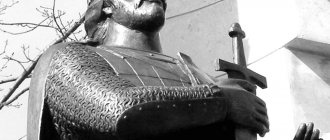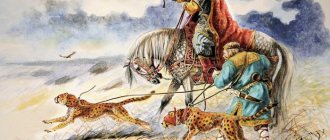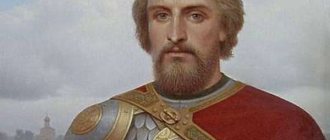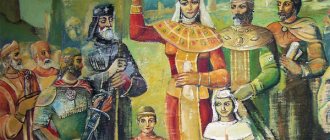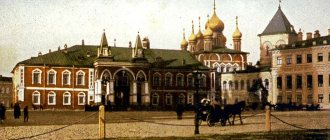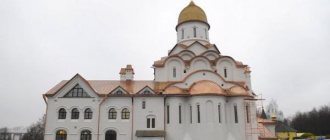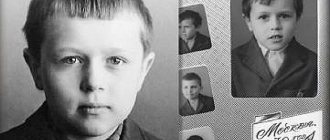Holy Blessed Prince Andrei Bogolyubsky (1111(?)-1174) - son of Grand Duke Yuri Dolgoruky, grandson of Vladimir Monomakh; Prince of Vyshgorod, Dorogobuzh, Grand Duke of Vladimir.
He received his nickname “Bogolyubsky” due to the fact that he gave a decree to found the city of Bogolyuby on the river. Nerl.
Andrei Bogolyubsky is one of the most prominent political figures of Ancient Rus'. During his reign, the capital of the state was moved from Kyiv to Vladimir, which had a huge impact on the further development of the state.
In the 18th century. was canonized by the Russian Orthodox Church as a saint; his relics are kept in the Assumption Cathedral in Vladimir.
Life and work of the prince
The future Grand Duke Andrei Yuryevich Bogolyubsky was presumably born in 1110-1111 in the Rostov-Sulzal land (northeast Rus'). His mother was a Polovtsian princess, the beloved daughter of Khan Aepa. Father - Yuri Dolgoruky, the youngest son of Vladimir Monomakh. Little is known about the prince’s childhood and youth. According to the surviving information, he received a decent education and good upbringing.
In addition, Andrei was able to become famous by accompanying his father in battles and campaigns dedicated to the only goal - the fight for the main ancient Russian throne. In 1146, together with his brother Rostislav, he expelled Prince Rostislav Yaroslavovich from Ryazan, who fled to the Polovtsy. In 1149, when Yuri Dolgoruky occupied Kyiv, he took possession of Vyshgorod and showed valor in the capture of Lutsk and the siege of Chernigov.
Historians are still arguing why Andrei took possession of Vyshgorod, which was not a remarkable city. The fact is that the father was going to make his son his successor after his death, and therefore kept him close to him.
Origin of the nickname
Contrary to the opinion of his father, in 1155 Andrei headed to Vladimir-on-Klyazma. From the city monastery he took with him an icon of the Mother of God, brought from Constantinople and painted by the holy evangelist Luke. The shrine was protected and was famous for its miraculous properties. However, the ruler managed to persuade the priest, kidnapped her and fled the city.
On the way, he dreamed of the Mother of God, who asked him to leave the icon in Vladimir. The ruler did so, and on the spot where he had the vision, he founded the stone city of Bogolyubov (now the village of Bogolyubovo, two kilometers from Vladimir). Here in a large castle his residence was located for a long time.
Government and religion
In 1157, after the death of his father, the prince became “autocratic of the Suzdal land.” He refused to move to Kyiv, and, despite the established custom, remained in Vladimir. The city became the new capital of the state. During his reign, Bogolyubsky subjugated many lands and gained political influence in the northeast of the country. Like all princes of the feudal era, he tried to elevate his own principality and subjugate the others.
The main characteristic of the prince's reign is the desire for independence from the influence of other countries. In religion, he created the cult of the Mother of God, in whose honor churches were built in Vladimir, Kyiv, and Novgorod. In addition, Byzantium was given permission to transfer the Rostov diocese to Vladimir. During the reign of Bogolyubsky, the religious holidays of the Intercession (October 1, old style) and the Savior (August 1) were established.
Military successes
Chroniclers note the prince's excellent military qualities. He had both successes and defeats, but in all battles Bogolyubsky showed courage. In an effort to create a strong and powerful principality, he participated in the following battles:
- Trip to Kyiv. The city was taken by storm on March 8, 1169. The purpose of the victory was to subject the city to ruin and weaken its influence. The prince did not want to rule here and placed his brother Gleb on the throne. After the murder of Gleb in 1771, the throne passed to Roman Smolensky, from whom Bogolyubsky demanded to hand over the boyars involved in the murder of his brother. Having been refused, he again went to Kyiv.
- After solving the problem of Kyiv, Bogolyubsky went on a campaign against Novgorod, but lost the battle to the city army (February 25, 1770). Without giving up, he blocked the supply of grain to the city. Fearing famine, city residents recognized the power of Bogolyubsky.
- Campaigns against the Volga Bulgars (an external enemy) had been undertaken since 1164. During the first of them, Andrei, together with his squad, was able to burn 3 large cities and take Bryakhimov (Ibragimov). In the winter of 1171, during the second campaign, the princely squads waited for help from the boyars at the confluence of the Oka and the Volga. However, they never showed up, citing the inopportune time of year. In fact, ignoring the order to collect was evidence of tension in the relationship between the ruler and the nobility. The troops nevertheless entered the land of the Bulgars and began looting. The Bulgars opposed it, and the princely army did not want to go further, since the balance of forces was not in its favor.
Kuchkovich Conspiracy
Carrying out his domestic and foreign policies, Andrei Bogolyubsky was able to add new lands to the territory of the Vladimir-Suzdal principality. This happened in the east at the expense of the Volga Bulgaria (the founding of Gorodets-Radilov), as well as in Zavolochye and in the north. However, the crisis of power became noticeable in 1172, during the second campaign against Bulgaria, which did not find support among the Murom-Ryazan princes.
The roots of stress should be sought in the social sphere. Bogolyubsky's reign was emphatically aristocratic, accompanied by military measures and serious expenses from the treasury. This led to increasing contradictions in relations with the Rostov-Suzdal and Vladimir boyars.
In 1174, Prince Andrei fell victim to a conspiracy organized by the boyar family of the Kuchkovichs, who were close to him. He was killed on the night of June 29, 1174, in the palace chambers. The conspirators (20 people) broke down the door and entered the room where the unarmed prince was resting. He resisted but was killed. In the morning, the conspirators plundered the treasury and killed the prince's favorite. The description of this historical event, recorded by an eyewitness or from the words of eyewitnesses, was preserved in the Kyiv Chronicle.
When considering a crime, the following facts should be taken into account:
- The prince's lack of weapons during the assassination attempt. In the feudal era, conspiracies were common, so nobles were armed around the clock. Modern historians believe that the prince's housekeeper was bribed and hid his sword the evening before the assassination attempt.
- Organization of a conspiracy by boyars. This refutes the version according to which Andrei Bogolyubsky received less and less support from the people towards the end of his reign. On the contrary, it is believed that the prince ceased to enjoy the support of the boyars, who were actively fighting for power. The reason for their negative attitude is Andrei’s struggle with the permissiveness of the nobility.
Having received the news of the death of Bogolyubov, the common people rebelled against the participants in the conspiracy and took the lives of many of them. If the prince had not enjoyed the support of the people, it is unlikely that his death would have caused such a reaction. Thus, the conspiracy against the prince is the result of the oppression of the boyars in order to strengthen their own autocracy.
The relics of the prince are in the Assumption Cathedral in the city of Vladimir. In 1702 he was canonized by the Russian Orthodox Church. The memory is honored on July 4 (19).
Property concept
Interpersonal connections relating to ownership, disposal, movement, and use of material goods are called property relations. Initially, such relationships were regulated by tradition and customs, but in modern society they are established on the basis of legal norms.
The peculiarity of property relations is that they presuppose the presence of other social connections. So the owner, manager and user are not the same person, but completely different individuals.
Most often, property is the basis of a number of obligations that are fixed in legal relations. There are such forms of ownership: personal, private, collective and state.
Descendants of Andrei Bogolyubsky
In 1148, Andrei's father married Ulita, the daughter of the state boyar Stepan Kuchka. She was famous for her beauty and bore her husband five children. History has preserved their names:
- Izyaslav. He took part in the campaign against Volga Bulgaria and died in 1165. He was not married and left no children.
- Mstislav. Participant in many military campaigns, died in 1173. He had a son, Vasily (b. 1171), whose fate is unknown.
- Yuri Andreevich Bogolyubsky. In 1185-1189 - husband of Queen Tamara, with whom the golden age in the history of Georgia is associated. Died around 1190
- Rostislav. The wife of the last representative of the Chernigov Davydovich branch - Svyatoslav Vladimirovich. There is no information about descendants.
- Gleb Vladimirsky. Saint, unknown in chronicles. According to later sources, from the age of 12 he read spiritual literature and communicated with monks. He died at the age of twenty shortly before the death of his father.
Bogolyubsky’s wife belonged to the Kuchkovich family, and historians participated in an insidious conspiracy against her husband. For this she was executed. However, there is a version that the second wife (Ossetian, originally from Yaz) took part in the insidious murder, and it was she who was executed.
The table diagram shows the origin of the prince:
Economic sphere of society
The set of connections between people in which material wealth is created or transferred is called the economic sphere of society. It includes the production, exchange, distribution of various goods and services. This requires productive forces - tools, machines, as well as labor (people). During the production of goods, production relations develop between people.
Production forces and relations together represent the economic sphere.
The concept of “economics” originated in Ancient Greece. The word consists of two bases: “eikos” - economy and “nomos” - law, and means “management according to the law” or “skill of housekeeping”.
Man is the main productive force and source of economic initiative. There are two types of human effort:
- labor
- performers; - entrepreneurship
- organizers.
In modern society, science plays an important role in labor productivity. With its help, you can create new or simplify familiar tools.
TOP 4 articles that are read along with this
Interesting Facts
There is a lot of mystery in the life of a ruler. Historians do not know the exact date of his birth. Tatishchev indicated that he was killed at the age of 63. The day and year of death were recorded precisely - 06/29/1174. Consequently, the Grand Duke was born in 1111. However, there is an assumption that he was born in the period from 1120-1125. Anthropological research data supports it.
The prince’s appearance also causes a lot of controversy. His sculptural portrait is presented in school history textbooks. It is clearly visible that the face has pronounced Mongoloid features: narrow eyes, combed hair, prominent cheekbones, proudly raised eyebrows. However, after a study of the relics, which was carried out by the Institute of Forensic Medicine, the opinion about Bogolyubsky’s appearance changed . Scientists were struck by the following points:
- excellent preservation of the relics;
- lack of signs of belonging to the Mongoloid race;
- It has been established that the prince’s appearance is typical of a European.
Sources indicate that the prince’s mother was a Polovtsian. In the minds of Soviet anthropologists, the Cumans belonged to the Mongoloids. According to modern sources, these are people with blue eyes and blond hair. Consequently, the sculpture of Mikhail Gerasimov is the result of historians’ erroneous ideas about the Polovtsians.
The scientists were surprised by the strong torsion of Andrei’s humerus, which indicated colossal physical exertion. There is information that from an early age he was raised as a warrior, and at the age of 3 he could control a horse well. According to anthropologists, Bogolyubsky mastered special battle tactics that were unusual for Russian soldiers.
Where did the Grand Duke learn battle techniques? Scientists have found that until 1148 his name was practically not mentioned in chronicles. By that time he was many years old, and nothing is known about his life in his youth. In one of the Old Believer Lives of Andrei it is said that the prince stayed in Jerusalem for many years. On the holy land he spent time in fasting and prayer. It is likely that in Jerusalem he met warriors from whom he learned martial arts.
The prince spoke six languages and carried on active correspondence with Frederick Barbarossa (commander, knight, emperor of the Holy Roman Empire). His pedigree includes all the ruling dynasties of the era. A quarter Greek and Anglo-Saxon, he forever remained devoted to the Zalessk lands (Vladimir-Suzdal region).
Scientists speak of the ruler as an experienced strategist, architects - as an outstanding designer, musicians - as a connoisseur of beauty. The Church honors him as a saint who tragically ended his life. Everyone, without exception, recognizes him as a gifted personality, a patriot, whose activities helped create a center of Orthodox culture from Vladimir.
On the coat of arms of the principality, Andrei planted the same lion that was on the coat of arms of Jerusalem. This is not only a tribute to tradition, but also a direct indication of the spiritual connection with the holy place and the desire to glorify Vladimir as the new center of the Earth.
Cultural heritage
The merits of Andrei Bogolyubsky's reign include not only measures to protect borders from nomads and defending independence from external forces. Everything that the land of Vladimir is proud of was created by the power of the creative spirit of the ancient ruler. This is the Church of the Intercession on the Nerl, the Golden Gate, the golden-domed Assumption Cathedral, the white stone chambers in Bogolyubovo.
There is no fuss at the relics of St. Andrew. Pilgrims who wish to bow to him quietly wait for their turn. Here, in the Assumption Cathedral, his son Gleb rests. According to historical sources, he was poisoned. However, many believe that Gleb begged for his death, foreseeing the death of his father.
The staircase tower in which Bogolyubov received the fatal blow was reconstructed. There is an unusual energy in her that cannot be expressed in words. The Bogolyubskaya Icon of the Mother of God is a masterpiece of ancient Russian painting of the 12th century. It is stored in the Vladimir-Suzdal Historical, Architectural and Art Museum-Reserve under special conditions (temperature - 18 degrees, humidity - 50 percent). Every year a special commission examines the icon and assesses its condition.
Andrey made a significant contribution to the history of Rus'. During the era of his reign, the Vladimir-Suzdal principality achieved unprecedented power, and subsequently became the core of the Russian state.

